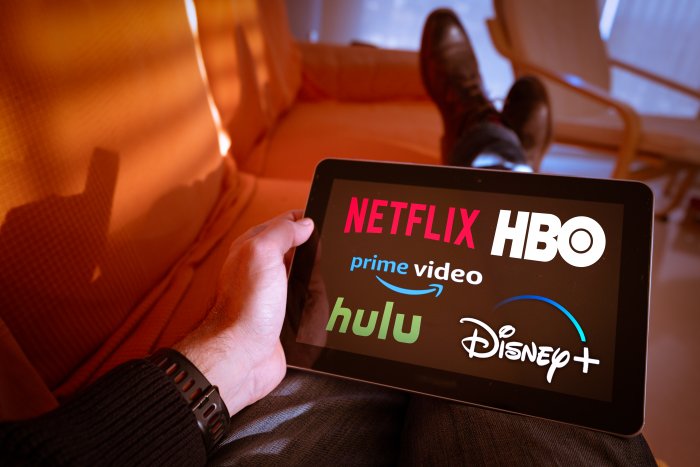Online Streaming Expected to Grow Faster in Hungary than CEE

Photo by Ivan Marc/Shutterstock.com
Thanks to new business models and a new approach to customers, giant technology platforms are rapidly gaining ground in media and content consumption.
Photo by Ivan Marc/Shutterstock.com
If you visit Rotten Tomatoes, the U.S.-based review-aggregation website for film and television, you will see three main sections to pick from: “In Theaters”, “DVD and Streaming” and “TV Shows”. IMBD (Internet Movie Database), the go-to online database of information related to films, television programs, home videos, video games, etc. also has a section on streaming content among “Special features”.
Today no trusted site specialized on TV and movies can afford to not have space dedicated to streaming, the most recent way of content consumption which, sooner or later is about to take over traditional methods of watching films. At least, that is, among the young, those aged under 35. They who are more mobile, have a much shorter attention span and demand content be streamed so they can watch it with no limits on time, location or device.
Streaming is a great example of how content consumption has been changing, and what response creators and platforms give. Since watching content is no longer reduced to a place or a period of time, or even a type of content, tech giants such as Amazon, Apple, and Disney, whose businesses now span social media, e-commerce, gaming, and mobile device ecosystems, are best positioned to win over customers.
They are the ones that, due the variety of businesses and platforms where they are present, can reach any customer. These companies don’t necessarily have to offer original content, though for the sake of competitiveness and maximizing profit they are better off doing so.
The basic idea is that by offering one type of content, that will promote and strengthen other elements as well. For these tech giants, media and content are just one offering in a much larger ecosystem to capture consumers’ time and wallet in what a study by Big Four consultancy KPMG calls a “Race for the platform” .
Five Keys
In its study, KPMG highlights five key areas that drive the expansion of tech giants. Their wide customer base that navigates through platforms with ease and is also committed thank to quality services they receive is a great basis for scalability.
These customers are also an endless source of data which allows tech giants to analyze trends and habits and tailor content accordingly. Data generated and collected by traditional media services are far less exact and reliable than what Facebook, Amazon or Google can access.
For these player, content itself is not the major source of revenue, though it is definitely a driver of that. Revenues from other business lines allows them to finance the often loss-making activities such as content creation or streaming live content.
They are also quick to innovate having no legacies (e.g. infrastructure) that would drag them down or would prevent them from stepping into new territories, the study points out. And when it comes to pricing, product bundling helps them offer more favorable prices.
However, the pace at which habits and traditional media consumption change may not be in line with the speed technology is evolving. A good indicator is how advertisement revenues at different mediums change.
“In Central and Eastern Europe, TV ad revenue will grow by an average of 5% per year over the period 2018-2023,” says Miklós Zaránd, head of technology, media and telecommunications advisory at PwC Hungary.
The same figure for video streaming is 14.8%, but it does not reach one thousandth of TV revenue either globally or regionally. “So the direction is pretty clear: by 2023, online streaming revenue will reach 25% of traditional TV advertising revenue,” he adds.

Miklós Zaránd
Live Content
TV service providers are trying to compete by creating their own content and launching their own online platforms to keep their viewing base. In addition, the focus of linear television will be the broadcasting of live content, in particular sporting events.
The video streaming market in Hungary is still very small, with an estimated value of HUF 12 billion. In the region, the only country where PwC expects to see a market share lower than this until 2023 is Romania. At the same time, the expansion predicted for Hungary is significantly faster than in the region.
The market is expected to grow quickly at a compound annual growth rate of 17.6%, and will reach HUF 28 billion by 2023, according to PwC’s forecast. Most globally available streaming services are already present: Netflix was to the first to appear in January 2016. It was followed by HBO and Amazon Prime at the end of 2017. Amazon’s e-sports streaming platform, Twitch, is also popular among younger generations and the vast majority of Hungarian gamers and e-athletes.
In Hungary, the fact that viewers are used to dubbed programs, rather than subtitles, is currently the biggest barrier to the spread of globally available content. This is a minor issue for some service providers, for example HBO, which already dub films. Hungarian subtitles are starting to appear on content from global service providers, however.
Beyond language, another barrier for more content to find Hungarian viewers is market size. Tech giants such as Amazon, Disney Go or Netflix are targeting larger markets where there is more return on their investments. These include Latin America or in Europe countries such as Germany, the Netherlands, and the United Kingdom.
SUPPORT THE BUDAPEST BUSINESS JOURNAL
Producing journalism that is worthy of the name is a costly business. For 27 years, the publishers, editors and reporters of the Budapest Business Journal have striven to bring you business news that works, information that you can trust, that is factual, accurate and presented without fear or favor.
Newspaper organizations across the globe have struggled to find a business model that allows them to continue to excel, without compromising their ability to perform. Most recently, some have experimented with the idea of involving their most important stakeholders, their readers.
We would like to offer that same opportunity to our readers. We would like to invite you to help us deliver the quality business journalism you require. Hit our Support the BBJ button and you can choose the how much and how often you send us your contributions.









